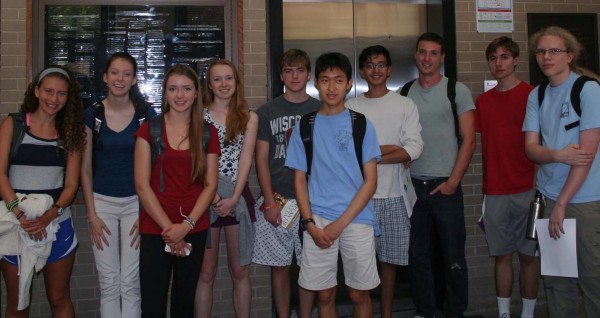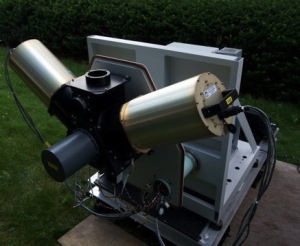MMSD internship fosters positive collaboration

High school students participating in Madison Metropolitan School District’s Science Research Internship Program toured the AOSS building in August. Matthew Westphall, pictured second from right, was paired up with a mentor on the AERI research group at SSEC. Photo Credit: Sarah Witman, SSEC.
Each summer, high school students participating in Madison Metropolitan School District’s (MMSD) Science Research Internship Program are paired with UW-Madison researchers, allowing the young scientists to gain valuable research experience while earning high school and college credit.
Matthew Westphall, now a senior at Madison West High School, enrolled in the MMSD program last summer, opting to spend his vacation months interning at the Space Science and Engineering Center (SSEC).
Westphall’s interest in physics and atmospheric science, along with membership in his school’s rocket club, led him to explore SSEC’s Atmospheric Emitted Radiance Interferometer (AERI) group online. Thinking it seemed like a good fit, he contacted SSEC Scientist Jonathan Gero, who agreed to be his mentor for the internship.
“Matthew was a peer, a part of the team from the start,” Gero said.
The AERI was designed by SSEC scientists and engineers to measure down-welling infrared radiation from the Earth’s atmosphere. The observations can be used for retrieving atmospheric profiles of temperature and water vapor as well as trace gas concentrations, investigating the radiative properties of clouds and aerosols, and improving radiative transfer models: important metrics for studying the environment.
After receiving some training and key background information about the AERI program, Westphall was asked to begin analyzing and validating real field data for the project.
“I had no idea what I was going to be doing,” Westphall said. “But it worked out well. I was surprised at how friendly and helpful everybody was. It really made it a nice experience for me.”
“Matthew had some programming experience before, but he basically picked up Python on his own with some help from the students in our lab,” Gero said. “By about a third of the way in, he was able to function independently.”

The Atmospheric Emitted Radiance Interferometer (AERI), pictured here at UW-Madison’s Atmospheric, Oceanic and Space Sciences building, was designed by SSEC scientists and engineers to measure down-welling infrared radiation from the Earth’s atmosphere. Photo Credit: Denny Hackel, SSEC.
Specifically, Westphall worked to improve an algorithm to automate the comparison of measurements made by the AERI and those made by weather balloons. This process ensures that the AERI measurements are as accurate as possible.
Scientists launch a weather balloon and apply a model to get a calculated spectrum that can directly be compared to the measured spectrum from the AERI. Every time a weather balloon is launched at a field site with an AERI, usually twice or more daily, the scientists can test the accuracy of the AERI measurement.
“This is a great way to see how well the AERI is working,” Gero said.
This is hardly the type of work that might be expected of a typical teenager. But a valuable tenet of the program is that it places emphasis on students’ abilities, rather than their age.
“Matthew is definitely really bright. If someone is good at what they do, it doesn’t matter how old they are. Research requires competency and scientific maturity, and he displayed both of those,” Gero said.
“There was a steep learning curve at the beginning, just getting acquainted with the basics of the project, but after that it was pretty manageable,” Westphall added. “It was one of the best summers I’ve ever had … and it has definitely inspired me to pursue the sciences further.”
Gero says the MMSD program has likely strengthened the students’ college applications, adding that he has asked Westphall to consider working with the AERI group again next summer as an employee.
It is paramount for budding scientists and engineers to get experience in the fields in which they hope to work, and the mentorship that these working scientists provide is equally invaluable.
“When I was applying to graduate school, I already had hands-on research experience in atmospheric science, and that is not true for every undergrad. So the fact that Matthew has been able to get that kind of experience as a high school student is really amazing,” Gero said.
The benefits from MMSD’s internship program are a two-way street. Beyond directly advancing the progress of research at SSEC, Gero sees the program as a long-term investment in science.
According to Gero, it is important to mentor the next generation of scientists and engineers. Regardless of whether they come back to work at SSEC, they will be able to speak positively about their internship experience, and share the excitement with others.
“What I found most interesting was that the students said the program helped them learn that scientists are actually really approachable,” he said. “People have this idea that scientists and professors are elite, or alien. Yet, all these research groups on campus welcomed these high school students and treated them as peers. I think that had a huge impact on how the students view our field.”
While it was SSEC’s first time participating in the internship program, Gero says he hopes the partnership will continue in coming years.
“It’s definitely an excellent program; I highly recommend it,” he said. “The schools do the hard work of selecting talented students, so we are likely to get someone who is high-achieving and motivated. I absolutely would do it again.”
Westphall and the other students in the MMSD internship program have written formal research papers on their experiences, and they will present posters at a special event Nov. 4 on the UW-Madison campus.
